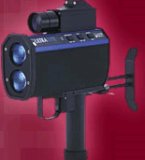10/17/2005
London Paper Documents US Laser Gun ErrorsAn investigation of a popular laser speed gun finds both technical accuracy errors and a significant conflict of interest in court testimony.

After testing American-specification laser speed guns, London's Daily Mail newspaper concludes that the popular LTI 20-20 Ultralyte model is prone to "wild" errors. Specifically, a wall was found to travel at 44 MPH, an empty road 33 MPH, a parked car 22 MPH, and a slow-moving bicycle at 66 MPH. These findings match those of the BBC who investigated the same device in March and September.
The Daily Mail also documented a significant new error. The LTI speed gun can report the speed of an overtaking vehicle, even if the slower automobile is being targeted. The Daily Mail was careful to perform all tests while precisely following both police guidelines and instructions from the device manufacturer, Laser Technology Inc. The test gun was certified accurate at the headquarters of Tele-Traffic, the device's UK importer.
One in five UK motorists have received a speeding ticket with essentially every UK force having at least one LTI gun for use in mobile speed camera traps. The device is also popular among American police forces.
On at least ten occasions, UK motorists learning of the gun's accuracy problems have attempted to contest their ticket in court. After requesting the video footage from the LTI speed camera version of the gun, the motorists found that the Crown Prosecution Service had quietly dropped their case.
These prosecutors primarily use one man, Frank Garratt, as the "expert witness" in court regarding the technical accuracy of the LTI gun. Garratt has become a millionaire as head of Tele-Traffic and therefore has a direct financial interest in defending the device's accuracy.
Accuracy problems most often occur when the laser beam "slips" from one portion of a vehicle to another and the distance of the slippage is added to the calculation that determines the speed readout. For example, if the speed gun's aim point slips from the windshield to the grill, the speed reading will be 8 MPH too high. Slippage occurs if the operator moves his hand "the thickness of a human hair," according to the BBC's expert. Additional errors happen when the laser beam reflects off of nearby vehicles.
"The reason is that the gun's technology presumes that there is always a direct line between the police operator and the speeding vehicle," laser expert Dr. Michael Clark explained. "But the beam sometimes catches the reflection of a nearby car. It zigzags to this car before carrying on to the target vehicle and returns by the same route."


